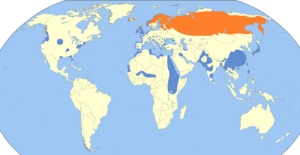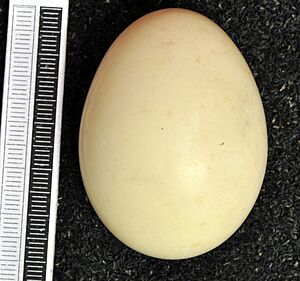Eurasian wigeon facts for kids
Quick facts for kids Eurasian wigeon |
|
|---|---|
 |
|
| Male (rear) and female (front) | |
| Conservation status | |
| Scientific classification | |
| Genus: |
Mareca
|
| Species: |
penelope
|
 |
|
| Synonyms | |
|
|
The Eurasian wigeon (Mareca penelope) is a type of dabbling duck. It's also known as the European wigeon. These ducks are very common and can be found across a large area called the Palearctic, which includes Europe and parts of Asia. They are one of three types of wigeon ducks.
Contents
About the Eurasian Wigeon
How the Wigeon Got Its Name
The Eurasian wigeon was first officially described in 1758 by a famous scientist named Carl Linnaeus. He gave it the scientific name Anas penelope. The word Anas is Latin for "duck." The name penelope comes from an old story about a duck that supposedly saved a person named Penelope.
What Does a Wigeon Look Like?
These ducks are about 42 to 52 centimeters (16.5 to 20.5 inches) long. Their wings can spread out to about 71 to 80 centimeters (28 to 31.5 inches). They usually weigh between 500 and 1073 grams (1.1 to 2.4 pounds).
When a male wigeon is ready to breed, it looks quite colorful. It has grey sides and back, with a black rear. Its wings have a dark green patch and a bright white area that you can easily see when it flies or rests. The male also has a pink chest, a white belly, and a brown head with a creamy-white stripe on top.
When the male is not breeding, its feathers change. It looks more like the female. Female wigeons are mostly light brown. You can often tell them apart from other ducks by their shape.
Where Do Eurasian Wigeons Live?
Eurasian wigeons breed in the northern parts of Europe and Asia. They are like the cousins of the American wigeon, which lives in North America.
These ducks travel long distances. They spend their winters much further south than where they breed. You can find them in southern Asia and Africa during the colder months. In places like Great Britain and Ireland, many Eurasian wigeons visit in winter. Only a few pairs stay to breed in certain areas like Scotland or the Lake District. Sometimes, they visit the United States, especially along the mid-Atlantic and Pacific coasts.
Wigeon Behavior and Habitat
Eurasian wigeons like to live in open wetlands. This includes wet grasslands or marshes that have some taller plants. They mostly eat plants, which they find by dabbling in the water or grazing on land.
They build their nests on the ground, usually close to water and hidden by plants. Outside of the breeding season, these ducks love to be together in large groups. They might even join up with flocks of American wigeons in the United States.
What Sounds Do Wigeons Make?
Eurasian wigeons are known for being quite noisy birds! The male makes a clear whistling sound that sounds like "pjiew pjiew." The female, on the other hand, makes a low growling sound, like "rawr."
Conservation Status
The Eurasian wigeon is part of an agreement to protect migratory waterbirds in Africa and Eurasia. This is good news because it helps keep their populations healthy. Currently, their conservation status is listed as "least concern," which means they are not in danger of disappearing.
Images for kids





